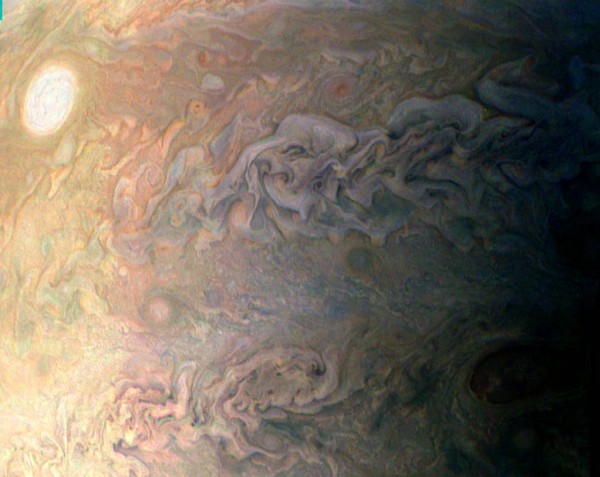By Ana Verayo, | January 28, 2017

This amateur-processed image was taken on Dec. 11, 2016, at 9:27 a.m. PST (12:27 p.m. EST). (NASA/JPL-Caltech/SwRI/MSSS/Eric Jorgensen)
The famous Great Red Spot on Jupiter is a gigantic storm swirling over the gas planet. In the latest image from NASA, Jupiter probe Juno captured the stunning, massive storm in high-resolution detail, swirling with the thick clouds, revealing a glorious marbled atmosphere.
Like Us on Facebook
This gigantic storm is driven by large-scale winds and powerful circulations. It also possesses a core region filled with high atmospheric pressure. Winds in this region can reach up to 384 miles per hour.
The storm appears to be faded in color, appearing to be a smudge of pale brown in the central region. It seems to be in the process of blending into an ancient cosmic marble.
This newest image captured by Juno is courtesy of its onboard camera, the JunoCam. It was taken on December 11, 2016, as the spacecraft completed one of its closest flybys of the gas giant. This photo was captured when the spacecraft was just around 10,300 miles above the cloud tops of Jupiter.
Astronomers and scientists have long been fascinated by Jupiter's extreme weather systems including its massive storms, supersonic wind jets along with its Great Red Spot which is also considered to be the biggest storm in the solar system.
In a new study, scientists from the University of California, Los Angeles recreated these wind forces inside a garbage can to unravel the mystery of whether these superfast jets can only exist in a planet's upper atmosphere.
UCLA geophysicist Jonathan Aurnou and his team simulated the powerful jet streams of Jupiter inside a laboratory for the first time and discovered that the winds are most likely to be as vast as thousands of miles across Jupiter's atmosphere.
Scientists say that the real challenge here is to recreate these swirling winds and build a computer model of Jupiter with three key attributes that are pivotal in jet formation such as turbulence, rapid rotation, and a "curvature effect" that can simulate the shape of the planet.
Scientists were able to fill an industrial sized garbage can with 105 gallons of water. When the container spun, water was spilling over its sides and formed a parabola that incorporated the curved surface of Jupiter.
Researchers suggest that these wind jets run deep inside since they can be seen on the surface of the water even if turbulence was injected at the bottom of the can. This marks the first time that a lab experiment demonstrated how strong the jets are in Jupiter that can also appear and develop deep inside the real fluid.
This new study was published in the journal, Nature Physics.
-
Use of Coronavirus Pandemic Drones Raises Privacy Concerns: Drones Spread Fear, Local Officials Say

-
Coronavirus Hampers The Delivery Of Lockheed Martin F-35 Stealth Fighters For 2020

-
Instagram Speeds Up Plans to Add Account Memorialization Feature Due to COVID-19 Deaths

-
NASA: Perseverance Plans to Bring 'Mars Rock' to Earth in 2031

-
600 Dead And 3,000 In The Hospital as Iranians Believed Drinking High-Concentrations of Alcohol Can Cure The Coronavirus

-
600 Dead And 3,000 In The Hospital as Iranians Believed Drinking High-Concentrations of Alcohol Can Cure The Coronavirus

-
COVID-19: Doctors, Nurses Use Virtual Reality to Learn New Skills in Treating Coronavirus Patients







